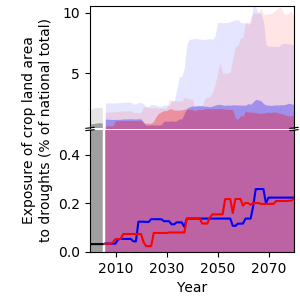Kenya: Agriculture
Smallholder farmers in Kenya are increasingly challenged by the uncertainty and variability of weather caused by climate change [21], [22]. Since most crops are rainfed, yields depend on water availability from precipitation. However, the length and intensity of the rainy season is becoming increasingly unpredictable and the use of irrigation facilities remains limited due to poor extension services and irrigation management, and lack of credit and technical equipment [23]. In 2003, only 28 % of the potential area (1 % of crop land) was irrigated [24]. The main irrigated crops are vegetables, fruit, coffee, rice and maize [23].
Crop land exposure to drought

Currently, the high uncertainty of projections regarding water availability (Figure 10) translates into high uncertainty of drought projections (Figure 11). According to the median over all models employed for this analysis, the national crop land area exposed to at least one drought per year will only slightly increase in response to gobal warming, while other models project a strong increase. Under RCP6.0, the likely range of drought exposure of the national crop land area per year widens from 0–0.8 % in 2000 to 0–1.6 % in 2080. The very likely range widens from 0–1.9 % in 2000 to 0–9.8 % in 2080. This means that some models project a fivefold increase in crop land area exposed to drought over this time period, while others project no change.
Crop yield projections

Climate change will have a negative impact on yields of millet and sorghum (Figure 12)5. Compared to 2000, yields are projected to decline by 8.0 % under RCP2.6 and by 5.3 % under RCP6.0 by 2080. The stronger decrease under RCP2.6 can be explained by non-temperature related parameters such as changes in precipitation, while the weaker decrease under RCP6.0 can be explained by the CO2 fertilisation effect under higher concentration pathways, which benefits plant growth. Yields of cassava are projected to gain from climate change, with a 25 % increase under RCP6.0. Cassava is a C3 plant, which follows a different metabolic pathway than millet, sorghum and maize (C4 plants), and benefits more from the CO2 fertilisation effect. Yields of maize, wheat and cow peas are projected to decrease slightly under RCP2.6 and to not change under RCP6.0, with the exception of cow peas which are projected to increase by 10.2 % under RCP6.0. Although there appears to be almost no change in multi-model median national-level yields of maize and wheat, some models simulate considerable increases. Regional climate variability will likely cause crop yields to increase in some areas and decrease in others.
Overall, adaptation strategies such as switching to high-yielding improved varieties in climate change sensitive crops need to be considered, yet should be carefully weighed against adverse outcomes, such as a resulting decline of agro-biodiversity and a loss of local crop types.
5 Modelling data is available for a selected number of crops only. Hence, the crops listed on page 2 may differ. Maize, millet and sorghum are modelled for all countries.
References
[21] M. Herrero, C. Ringler, J. van de Steeg, P. Thornton, T. Zhu, E. Bryan, A. Omolo, J. Koo, and A. Notenbaert, “Climate Variability and Climate Change: Impacts on Kenyan Agriculture,” Washington, D.C. and Nairobi, Kenya, 2010.
[22] E. Bryan, C. Ringler, B. Okoba, C. Roncoli, S. Silvestri, and M. Herrero, “Adapting Agriculture to Climate Change in Kenya: Household Strategies and Determinants,” J. Environ. Manage., vol. 114, pp. 26–35, 2013.
[23] FAO, “Irrigation Market Brief: Kenya,” Rome, Italy, 2015.
[24] AQUASTAT, “Irrigation and Drainage Development,” 2002.


